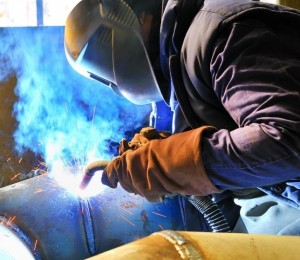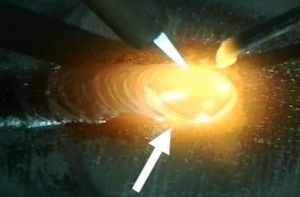Butt welding or butt weld of pipes is a special welding process that involves joining parts of steel pipes, angle, I-beam, sheet metal, other fittings or metal structures across the entire plane of touching elements using wire and other materials. Such welding is carried out under significant heat.
It is possible to perform butt welding in different ways. Among them:
- resistance;
- continuous fusion;
- fusion with heating.
The choice of butt welding method for beams, valves and other metal elements depends on the grade of the parts to be joined and their quality. In recent years in main pipelines, pressure and non-pressure systems, began to use not only pipes made of metal, but also corrosion-resistant PB, PVDF, polypropylene, polymer analogues of steel products. They are able to distill any, even very aggressive medium. Such pipes, like beams or metal fittings, are connected by butt welding.

Features and advantages of butt welding
Among specialists, welding of steel pipes is recognised as a rather delicate and painstaking type of work, if it is necessary to achieve maximum reliability of the connection. Despite the fact that the use of special wires, electrodes and other materials facilitates the task, ignorance of technology or lack of experience leads to poor performance of the task. As a result, contact butt welding turns out to be the cause of problems and even serious force majeure.
The technology of butt welding is used without preliminary edge preparation. Since no welding edges are required, financial and time costs are significantly reduced due to the absence of the need for additional operations. It is also important that the butt welding joint is not only economical, but also equally strong compared to the rest of the pipe, reinforcement, beam. This simplifies and facilitates installation, increases its reliability and safety.
Welding of metal products with different diameters can be performed at butt joints on the same machine. The many advantages and the simplicity of the process make this welding method the best value for money.
Materials and equipment
Metal and thermoplastic pipes are butt-welded using specialised welding machines (mechanical, electro-hydraulic). The resulting welding seam is sometimes even stronger than a metal pipe, beam or reinforcement.
Manual butt welding is possible when equipping non-pressure joints or structures with low mechanical load. The use of wire, electrodes, special heating elements requires experience and professionalism.
Even in private construction, laying water pipes, butt welding of pipes requires special skills. When carrying out the installation of structures made of metal in the countryside, butt welding of channels, joining beams in the construction of a house, fittings, pipes for sewerage and water supply equipment, etc. also do not need to prepare the edges for welding to make high-quality unbreakable connections, but the presence of machines for manual welding is necessary.
If welding is done only once, the purchase may not be cost-effective. It’s easier and more economical to call in the craftsmen.
Selecting the type of welding
A professional welder can quickly and accurately determine what type of welding should be used so that rebar, beams, pipes are welded in the best possible way. In order to make structures or install pipelines, different types of welding are used, not just butt welding, including edge preparation for welding.
It can be welding:
- gas;
- manual welding with the use of wire;
- electric arc welding (with metal electrodes);
- automatic and semi-automatic (with flux or shielded gas);
- electro-contact or bare butt welding (flux-cored or with electrode wire under high-frequency heating).

For small diameter pipes, the gas welding option is used. If the welding area increases, arc welding is more suitable. Parameters for selecting the option of welding products and metal are many. Joint welding of steel pipes or alloy products is carried out by masters with the choice of the optimal mode depending on the category of welded products.
Current control
When butt welding, it is very important to carry out an accurate calculation of the parameters of the current supply, as well as the speed of the process. Current control is essential.
Its increase or decrease is carried out in exact accordance with the tasks set for welding beams, pipes, fittings and so on, any metal products. By increasing the current strength, the master accelerates butt welding. With reverse polarity and reducing the current strength, the metal is melted more reliably, the depth of the weld increases. This is very important in restoration work on damaged metal products.
Hardware or manual labour
The strength of the butt joint of metal products depends on the type of welding machine used and the qualifications of the specialist. The welding seam is easy for even novice welders when using a special tool. Butt welders are equipped with a hydraulic drive, facilitating the task of the master in butt welding.
Manual labour is the domain of experienced specialists only. Lack of skills will not allow you to successfully carry out a complex operation to weld metal, especially butt welding. Sometimes products are so complex that they require the involvement of several master welders at the same time. They distribute the load among themselves, simultaneously welding on the rotary and non-rotary joints.
Stages of butt welding
For each stage of butt welding of pipes, beams, fittings and other metal products, there are their own regulations. They must be followed in full accordance with the values of wall thickness of the products to be joined, diameter, size, wire used and so on.
The regulations are usually prescribed in the operating manual of the welding equipment to be used for butt welding. At the same time, butt welding should be preceded by a number of preparatory measures.
Experienced masters strictly observe all the technological requirements of the process of butt welding of metal products. They are quite a lot.
If you adhere to all the rules and regulations, a really strong connection is created, designed for a long period of operation even under high loads. To achieve this, it is necessary to go through all stages, from preparation to the creation of the connection. The master will have to carry out:
- preparing the site for the placement of welding equipment in accordance with safety requirements;
- installation and fixation of pipes, fittings, beams and other products made of metal or alloys (special clamps are used for fixation, but welding is sometimes performed simply on the ground, and then lay the connected products (pipes) in a prepared trench);
- cleaning of welding surfaces, degreasing at the joints of products and wires (special preparation of the edge for welding is not required), pipe facing;
- heating of joints under high pressure or without pressure (depending on the type of product)
- Creation of the joint (welding itself);
- cooling down.
At the stage of preparation and fixation of pipes and other metal products for butt welding, it is necessary to carefully check whether the edges are not damaged, whether the hole is not blocked, whether the edges of the joined elements are not bent.
If welding is carried out in difficult weather conditions, it is also necessary at the initial stage of preparatory work to provide protection from atmospheric precipitation, and in case of gusty wind – from dirt, dust, sand, any fractions and elements that it brings. Their penetration into the welding place of beams, pipes, fittings and so on will adversely affect the results of the connection.
It is obligatory to apply special plugs, which will prevent the occurrence of drafts inside the connected metal products. Back-to-back welding with the help of special tools and equipment, using wire and other materials is used both for joining steel and alloy products with each other and for installation in the system with the use of connectors, fasteners and various trunk or system equipment.
Subtleties and peculiarities of butt welding
The welding method can be either left or right. It is desirable to weld in the lower position, continuously rotating the products to be joined. This type of joint is called a rotary joint. A joint that cannot be rotated is called a non-turned joint. Such joints are welded on the lower half of the pipe, then welded from the top in the opposite direction. The start and end of the seam of the upper part of the joint must overlap the seam on the lower part of the joint. In this case, the butt weld roll will be strong all round.
Joint welding depends directly on the reaction speed of the master and the clarity of technological operations. To simplify the process, some specialists insert rings into the pipes, however, it should be remembered that this is not always cost-effective, since the internal cross-section of the products is reduced.
As a result of this method of pipe welding, there is undesirable excessive resistance to the movement of the distilled medium in the pipeline. This is only cost-effective if the pipes are used as reinforcement for foundations, formwork and so on.
When creating pipe lines for transporting various media, it is better to use a socket connection. This type of connection when welding will not reduce the internal cross-section, but it will be necessary to prepare one end of the pipe in a special way. Some masters to strengthen the butt weld when welding pipes, beams and other fittings, put overlays or sleeves.
It is also possible to join pipes using “tack welds”. If the diameter is small, it is enough to put three or four such elements. The first tack is installed from the bottom. It is necessary to purchase tacking elements of high quality, otherwise they will also impair the quality of the joining seam.
Internal tension, which sometimes occurs when welding a rotary joint, should be welded in separate sections. This rule applies to small diameter items to be welded. In the case of large diameters, sometimes two or more welders weld simultaneously. In this case, the upper part of the product is welded first, then it is turned and the other parts are butt welded simultaneously.
Modern technologies and specialised tools nowadays make the task of masters much easier, however, you should not discount their experience, qualifications, many subtleties and peculiarities of the butt welding process. It is they who will avoid mistakes and poor-quality joints.